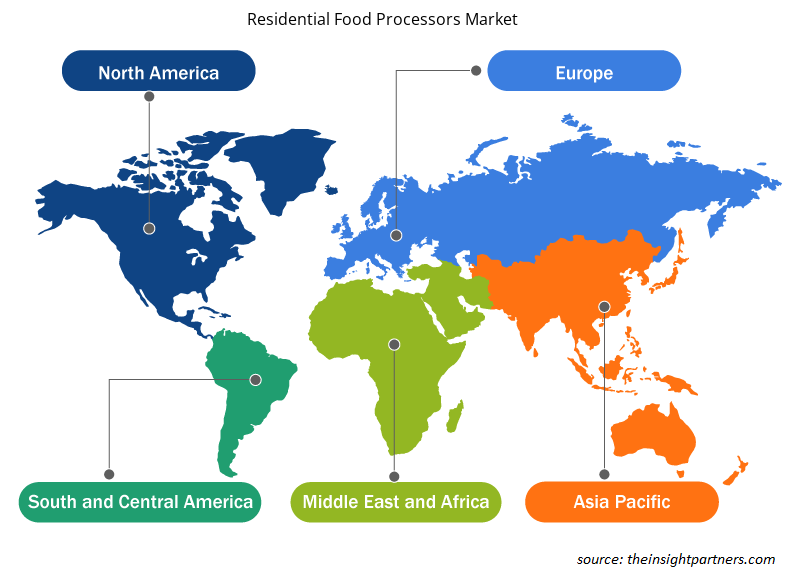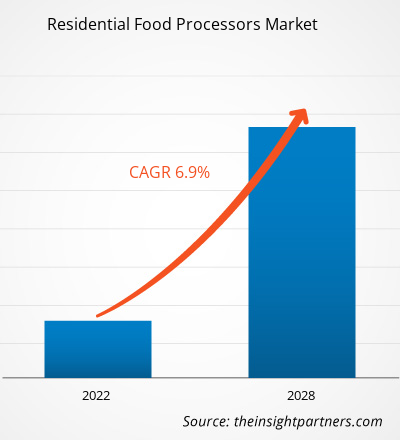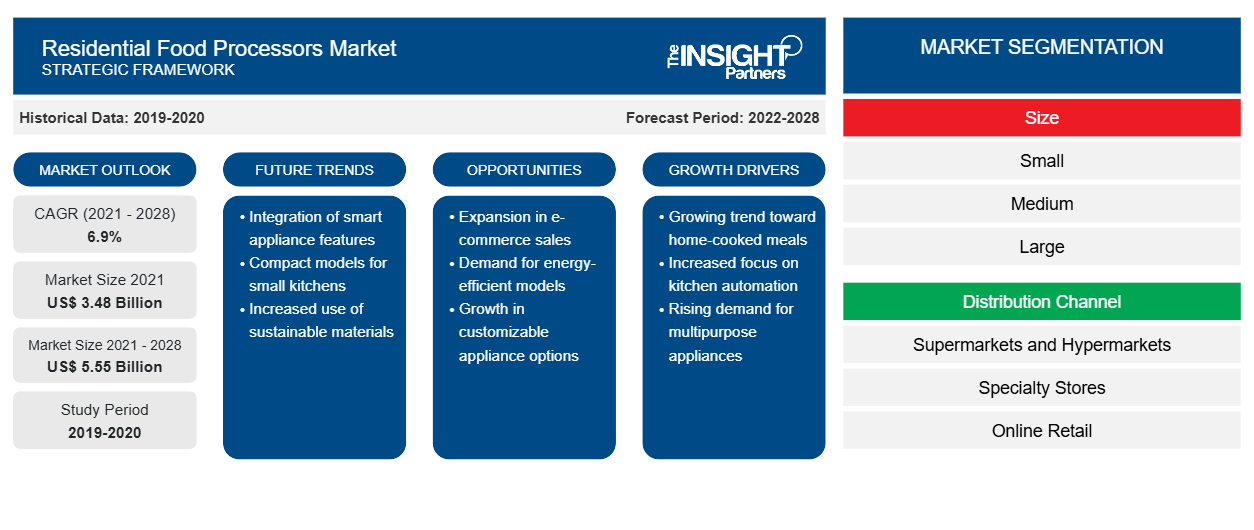Le marché des transformateurs alimentaires résidentiels était évalué à 3 475,21 millions USD en 2021 et devrait atteindre 5 553,20 millions USD d'ici 2028 ; il devrait croître à un TCAC de 6,9 % de 2021 à 2028.
Un robot culinaire domestique est un appareil de cuisine utilisé pour faciliter les tâches répétitives lors de la préparation des aliments. Les robots de cuisine sont aujourd'hui pour la plupart automatisés et facilitent la préparation des aliments.
En 2020, l'Asie-Pacifique a dominé le marché mondial des robots culinaires résidentiels et devrait conserver sa domination au cours de la période de prévision. L'augmentation de la population active dans la région a entraîné une demande croissante d' appareils électroménagers et de cuisine pratiques . Ces facteurs devraient propulser la demande de robots culinaires résidentiels dans toute la région. En outre, le changement de mode de vie des consommateurs a conduit à une adoption accrue d'appareils électroménagers et de cuisine modernisés. L'augmentation de la population dans des pays comme la Chine et l'Inde a entraîné une augmentation de la construction de maisons et de complexes résidentiels ayant un espace de cuisine limité. Ainsi, cela a conduit à une demande accrue de petits appareils de cuisine, tels que les mini-robots culinaires.
Personnalisez ce rapport en fonction de vos besoins
Vous bénéficierez d'une personnalisation gratuite de n'importe quel rapport, y compris de certaines parties de ce rapport, d'une analyse au niveau des pays, d'un pack de données Excel, ainsi que d'offres et de remises exceptionnelles pour les start-ups et les universités.
-
Obtenez les principales tendances clés du marché de ce rapport.Cet échantillon GRATUIT comprendra une analyse de données, allant des tendances du marché aux estimations et prévisions.
Informations sur le marché
Demande croissante de produits pratiques
Ces dernières années, le mode de vie des consommateurs est devenu mouvementé en raison de la pression accrue au travail, ce qui les fait se sentir épuisés après leurs heures de travail habituelles. Les professionnels préfèrent de plus en plus les appareils électroménagers et de cuisine pratiques, automatisés et intelligents qui peuvent leur faire gagner du temps et des efforts. Les robots culinaires domestiques sont multifonctionnels et rapides. Ces robots culinaires fonctionnent efficacement et de manière significative pour faciliter le processus de cuisson même si un utilisateur cuisine pour un grand nombre de personnes.
Informations sur la taille
En fonction de la taille, le marché des robots culinaires résidentiels est segmenté en petits, moyens et grands. En 2020, le segment moyen dominait le marché. La contrainte accrue de la taille et de l'espace des cuisines dans les pays en développement est l'un des facteurs qui stimulent la demande de robots culinaires résidentiels de taille moyenne. Le robot culinaire résidentiel moyen comprend un disque à trancher moyen, un disque à râper et une lame à hacher en acier inoxydable pour le traitement.
Koninklijke Philips NV , Whirlpool Corporation, Breville Group Limited, De'Longhi Appliances Srl , Conair Corporation, Robert Bosch GmbH , MAGIMIX , SharkNinja Operating LLC , Groupe SEB et Spectrum Brands Inc. comptent parmi les principaux acteurs du marché des robots culinaires résidentiels. Les principaux acteurs adoptent plusieurs stratégies, telles que les fusions et acquisitions et les lancements de produits, pour étendre leur présence géographique et leur clientèle.
Aperçu régional du marché des transformateurs alimentaires résidentiels
Les tendances et facteurs régionaux influençant le marché des robots culinaires résidentiels tout au long de la période de prévision ont été expliqués en détail par les analystes d’Insight Partners. Cette section traite également des segments et de la géographie du marché des robots culinaires résidentiels en Amérique du Nord, en Europe, en Asie-Pacifique, au Moyen-Orient et en Afrique, ainsi qu’en Amérique du Sud et en Amérique centrale.

- Obtenez les données régionales spécifiques au marché des transformateurs d'aliments résidentiels
Portée du rapport sur le marché des transformateurs d'aliments résidentiels
| Attribut de rapport | Détails |
|---|---|
| Taille du marché en 2021 | 3,48 milliards de dollars américains |
| Taille du marché d'ici 2028 | 5,55 milliards de dollars américains |
| Taux de croissance annuel moyen mondial (2021-2028) | 6,9% |
| Données historiques | 2019-2020 |
| Période de prévision | 2022-2028 |
| Segments couverts |
Par taille
|
| Régions et pays couverts |
Amérique du Nord
|
| Leaders du marché et profils d'entreprises clés |
|
Densité des acteurs du marché des transformateurs alimentaires résidentiels : comprendre son impact sur la dynamique commerciale
Le marché des robots culinaires résidentiels connaît une croissance rapide, tirée par la demande croissante des utilisateurs finaux en raison de facteurs tels que l'évolution des préférences des consommateurs, les avancées technologiques et une plus grande sensibilisation aux avantages du produit. À mesure que la demande augmente, les entreprises élargissent leurs offres, innovent pour répondre aux besoins des consommateurs et capitalisent sur les tendances émergentes, ce qui alimente davantage la croissance du marché.
La densité des acteurs du marché fait référence à la répartition des entreprises ou des sociétés opérant sur un marché ou un secteur particulier. Elle indique le nombre de concurrents (acteurs du marché) présents sur un marché donné par rapport à sa taille ou à sa valeur marchande totale.
Les principales entreprises opérant sur le marché des transformateurs alimentaires résidentiels sont :
- Royal Philips NV
- Société Whirlpool
- Groupe Breville Limitée
- De
Avis de non-responsabilité : les sociétés répertoriées ci-dessus ne sont pas classées dans un ordre particulier.

- Obtenez un aperçu des principaux acteurs du marché des transformateurs alimentaires résidentiels
Rapports en vedette
- Tendances progressistes dans le secteur des transformateurs alimentaires résidentiels pour aider les acteurs à développer des stratégies efficaces à long terme
- Stratégies de croissance commerciale adoptées par les entreprises pour assurer leur croissance sur les marchés développés et en développement
- Analyse quantitative du marché mondial des robots culinaires résidentiels de 2019 à 2028
- Estimation de la demande de robots culinaires résidentiels dans divers secteurs
- Analyse PEST pour illustrer l'efficacité des acheteurs et des fournisseurs opérant dans l'industrie pour prédire la croissance du marché
- Développements récents pour comprendre le scénario concurrentiel du marché et la demande pour les transformateurs alimentaires résidentiels
- Tendances et perspectives du marché associées aux facteurs qui stimulent et freinent la croissance du marché des transformateurs alimentaires résidentiels
- Compréhension des stratégies qui sous-tendent l'intérêt commercial à l'égard de la croissance du marché mondial des transformateurs d'aliments résidentiels, aidant au processus de prise de décision
- Taille du marché des transformateurs alimentaires résidentiels à différents nœuds du marché
- Aperçu détaillé et segmentation du marché mondial des transformateurs alimentaires résidentiels ainsi que de sa dynamique industrielle
- Taille du marché des transformateurs alimentaires résidentiels dans diverses régions avec des opportunités de croissance prometteuses
L'analyse du marché mondial des robots culinaires résidentiels jusqu'en 2028 est une étude spécialisée et approfondie de l'industrie des biens de consommation, avec un accent particulier sur l'analyse des tendances du marché mondial des robots culinaires résidentiels. Le rapport vise à fournir un aperçu du marché avec une segmentation détaillée du marché. Le marché des robots culinaires résidentiels est segmenté en fonction de la taille, du canal de distribution et de la géographie. En fonction de la taille, le marché est segmenté en petit, moyen et grand. En fonction du canal de distribution, le marché des robots culinaires résidentiels est segmenté en supermarchés et hypermarchés, magasins spécialisés, vente au détail en ligne et autres. En fonction de la géographie, le marché est segmenté en cinq régions principales : l'Amérique du Nord, l'Europe, l'Asie-Pacifique, le Moyen-Orient et l'Afrique, et l'Amérique du Sud et l'Amérique centrale.
Profils d'entreprise
- Royal Philips NV
- Société Whirlpool
- Groupe Breville Limitée
- Appareils électroménagers De'Longhi Srl
- Société Conair
- Robert Bosch GmbH
- MAGIMIX
- Société d'exploitation SharkNinja LLC
- Groupe SEB
- Marques Spectrum Inc.
- Analyse historique (2 ans), année de base, prévision (7 ans) avec TCAC
- Analyse PEST et SWOT
- Taille du marché Valeur / Volume - Mondial, Régional, Pays
- Industrie et paysage concurrentiel
- Ensemble de données Excel
Rapports récents
Rapports connexes
Témoignages
Raison d'acheter
- Prise de décision éclairée
- Compréhension de la dynamique du marché
- Analyse concurrentielle
- Connaissances clients
- Prévisions de marché
- Atténuation des risques
- Planification stratégique
- Justification des investissements
- Identification des marchés émergents
- Amélioration des stratégies marketing
- Amélioration de l'efficacité opérationnelle
- Alignement sur les tendances réglementaires























 Obtenez un échantillon gratuit pour - Marché des transformateurs alimentaires résidentiels
Obtenez un échantillon gratuit pour - Marché des transformateurs alimentaires résidentiels